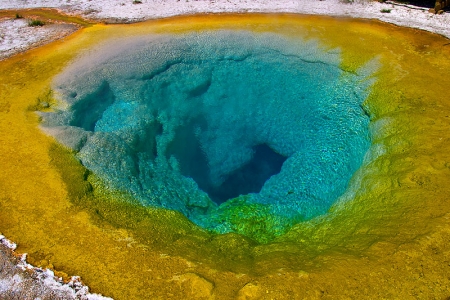Galería de Paisajes
Galería de Fuentes termales y piscinas
Galería de Fauna
Galería de Geysers
Galería de Terrazas
Galería de Cascadas de agua
Yellowstone National Park is located primarily in the U.S. state of Wyoming, though it also extends into Montana and Idaho. The park was the first of its kind, and is known for its wildlife and its many geothermal features, especially Old Faithful Geyser, one of the most popular features in the park. It has many types of ecosystems, but the subalpine forest is dominant.
Long before any recorded human history in Yellowstone, a massive volcanic eruption spewed an immense volume of ash that covered all of the western U.S., much of the Midwest, northern Mexico and some areas of the eastern Pacific. The eruption dwarfed that of Mt. St. Helens in 1980 and left a caldera 30 miles wide by 45 miles long.
That climactic event occurred about 640,000 years ago, and was one of many processes that shaped Yellowstone National Park–a region once rumored to be “the place where hell bubbles up.” Geothermal wonders, such as Old Faithful, are evidence of one of the world’s largest active volcanoes. These spectacular features bemused and befuddled the park’s earliest visitors, and helped lead to the creation of the world’s first national park.
Fur trappers’ fantastic tales of cauldrons of bubbling mud and roaring geysers sending steaming plumes skyward made their way back east. Several expeditions were sent to investigate, opening the West to further exploration and exploitation. In 1871, Ferdinand Hayden led an expedition that included artist Thomas Moran and photographer William H. Jackson. They brought back images that helped convince Congress that the area known as Yellowstone needed to be protected and preserved.
Indigenous Americans have lived in the Yellowstone region for at least 11,000 years. The region was bypassed during the Lewis and Clark Expedition in the early 1800s. Aside from visits by mountain men during the early to mid-1800s, organized exploration did not begin until the late 1860s. The U.S. Army was commissioned to oversee the park just after its establishment. In 1917, administration of the park was transferred to the National Park Service, which had been created the previous year. Hundreds of structures have been built and are protected for their architectural and historical significance, and researchers have examined more than 1,000 archaeological sites.
Yellowstone National Park spans an area of 8,983 km², comprising lakes, canyons, rivers and mountain ranges Yellowstone Lake is one of the largest high-altitude lakes in North America and is centered over the Yellowstone Caldera, the largest supervolcano on the continent. The caldera is considered an active volcano; it has erupted with tremendous force several times in the last two million years. Half of the world’s geothermal features are in Yellowstone, fueled by this ongoing volcanism. Lava flows and rocks from volcanic eruptions cover most of the land area of Yellowstone. The park is the centerpiece of the Greater Yellowstone Ecosystem, the largest remaining, nearly-intact ecosystem in the Earth’s northern temperate zone.
Hundreds of species of mammals, birds, fish and reptiles have been documented, including several that are either endangered or threatened. The vast forests and grasslands also include unique species of plants. Grizzlies, wolves, and free-ranging herds of bison and elk live in the park. Forest fires occur in the park each year; in the large forest fires of 1988, nearly one third of the park burned. Paved roads provide close access to the major geothermal areas as well as some of the lakes and waterfalls. During the winter, visitors often access the park by way of guided tours that use either snow coaches or snowmobile.
In 1872, President Ulysses S. Grant signed a law declaring that Yellowstone would forever be “dedicated and set apart as a public park or pleasuring ground for the benefit and enjoyment of the people.”
.

